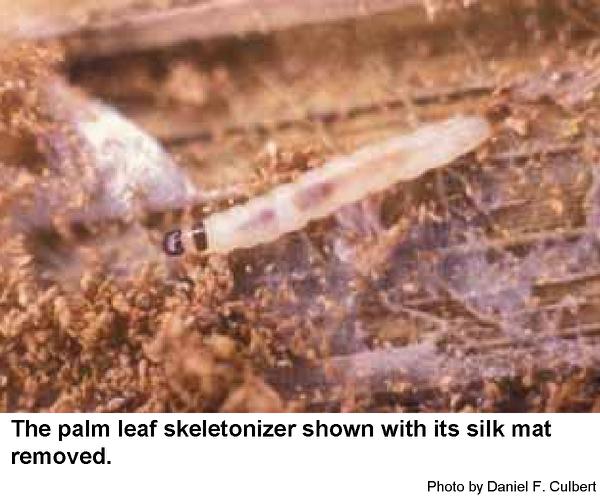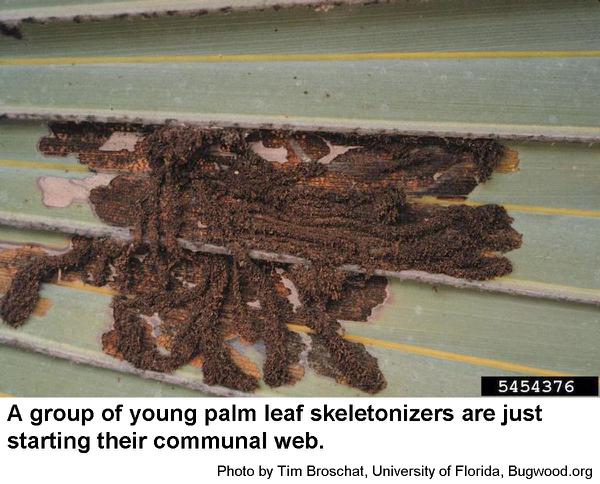Description and Biology
The palm leaf skeletonizer, Homaledra sabalella, is a native moth that attacks palms in the southern United States where it sometimes causes serious damage. The moth is a uniformly silvery light brown or beige with a black spot on the thorax and two black spots on each wing. When at rest, it is slender (just over 3 times as long as wide) and about 5/8 inch long. Females lay groups of about three dozen eggs on older palm leaves and then cover the eggs with a brown, papery material. After the caterpillars hatch, they usually construct silken tubes that are dark brown with frass. The caterpillars are almost colorless except for a brown patch on the thorax and the brown head. The tubes occur in dense groups and probably protect the caterpillars from the elements and perhaps from some predators. Eventually the caterpillars feed under a communal silk mat that is covered with frass. The caterpillars feed in groups of up to 100 on both the upper and lower surfaces of older leaves. They pupate under the silk webbing and sometime afterward, new moths emerge to mate and continue their "wheel of existence." Up to five generations occur per year, and there is no diapause.
Host Plants
Palm leaf skeletonizer feeds only on palms, including cabbage palmetto, Canary Island date palm, coconut palm, Latan palms, Puerto Rico hat palm, sabal palm, and 73 other palm species.
Residential Recommendations
Palm leaf skeletonizers are plagued with predators such as ground beetles and parasites including tachinid flies and small parasitic wasps. However, sometimes these biological controls are not effective enough to prevent unsightly damage. Experience in Florida where this pest is fairly abundant has shown that insecticides are often not effective in reducing palm leaf skeletonizers because the caterpillars are protected by their silk webbing. If large numbers of palms are damaged, cutting and burning infested leaves is reportedly an effective method of control. Specimen palms may be treated by washing the infested portion with a sponge or, if the palm is tough, spraying the infested areas with high pressure water to wash away the silk mat and dislodge the relatively fragile caterpillars.
References
- Palm Leaf Skeletonizer. Culbert, D. F. 2010. University of Florida IFAS Extension, UF/IFAS Okeechobee County Extension Service.
- Palm leaf skeletonizer, Homaledra sabalella (Chambers) (Lepidoptera: Coleophoridae). Anonymous. No Date. Forest Pest Insects in North America: a Photographic Guide.
- Extension Plant Pathology Publications and Factsheets
- Horticultural Science Publications
- North Carolina Agricultural Chemicals Manual
For assistance with a specific problem, contact your local Cooperative Extension Center.
This Factsheet has not been peer reviewed.
Publication date: Dec. 6, 2017
Reviewed/Revised: Oct. 27, 2022
Recommendations for the use of agricultural chemicals are included in this publication as a convenience to the reader. The use of brand names and any mention or listing of commercial products or services in this publication does not imply endorsement by NC State University or N.C. A&T State University nor discrimination against similar products or services not mentioned. Individuals who use agricultural chemicals are responsible for ensuring that the intended use complies with current regulations and conforms to the product label. Be sure to obtain current information about usage regulations and examine a current product label before applying any chemical. For assistance, contact your local N.C. Cooperative Extension county center.
N.C. Cooperative Extension prohibits discrimination and harassment regardless of age, color, disability, family and marital status, gender identity, national origin, political beliefs, race, religion, sex (including pregnancy), sexual orientation and veteran status.



